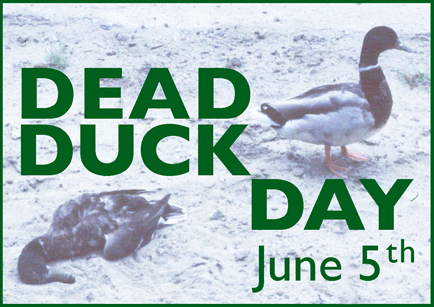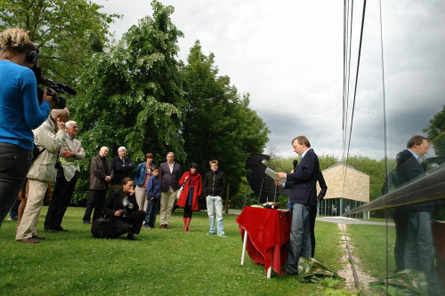Marc Abrahams's Blog, page 571
May 27, 2012
Detect & remove cadavers from amongst the live objects
As professor William J. Wepfer, of the George W. Woodruff School of Mechanical Engineering at the Georgia Institute of Technology puts things in his ‘Message from the School Chair’
“Today’s mechanical engineers might search the ocean with an underwater observation manipulator; work on developing systems to program robots for manufacturing; or build a prototype of an electric car or develop computer systems for automobiles.”
 But that’s by no means a complete list of activities for mechanical engineers at Georgia Tech.. They might, for example, also work on systems for intelligent automated transfer of live objects onto shackle lines.
But that’s by no means a complete list of activities for mechanical engineers at Georgia Tech.. They might, for example, also work on systems for intelligent automated transfer of live objects onto shackle lines.
Professor Kok-Meng Lee, (who heads the Advanced Intelligent Mechatronics Research Laboratory at the school) began developing just such a system back in 1998 – as a result of which he was granted a US patent in 2003:
“The system and method include introducing a plurality of live objects to a singulator. The singulator isolates the individual live objects and places them in a pallet on a conveyor. The system may detect and remove cadavers from amongst the live objects. The conveyor leads the live objects to a grasper. The grasper positions the legs of the live objects so that a shackler can secure the legs of the live objects with a shackle. The live objects and the shackle are then inverted and passed on to a shackle line. The shackle line may be a kill line buffer or a kill line.“
For the purposes of the invention, the ‘live objects’ mentioned above would preferably be chickens.
As part of the engineering development scheme, the chickens were mathematically modelled as an idealised ellipsoid, with the equation describing the motion of the chicken in the x direction through the rubber-fingered singulator as :
“It should be noted, however, that when the chicken goes through the singulator backward the resistance is much greater due to the chicken flapping its wings.”
An extensive description of the project to develop a system for intelligent automated transfer of live birds to a shackle line can be found here. ( Caution: the .pdf features graphic photos which some bird lovers may find disturbing.)
Further reading :
• ‘Automated shackling: how close is it?’ A. Bruce Webster and Kok-Meng Lee, Poultry International, Vol. 42, Number 4, April 2003, pp.28- 36. ( Caution: as above)
• And the entire project is described here:

Today is Riddle of a Riddle Day
Today, which we proclaim to be Riddle of a Riddle Day, we celebrate scholarly works titled “Riddle of a Riddle”. Well, we celebrate one of them, as it may be the only one there is:
“The Riddle of a Riddle,” Ivan Gaskell, Contemporary Aesthetics, March 8, 2008. The author, at Harvard University, writes:
ABSTRACT: This paper examines the distinction made by Arthur C. Danto between artworks and what he terms “mere real things.” It presents an eighteenth-century tool for sifting grain (a riddle) as a case study in the contexts of first, the house of its first known owner, General Artemas Ward (1727-1800); second, an exhibitioin 2006-7 drawn from the contents of that house pointedly held in an art museum; and, third, the likely maker of the object, a member of Hassanimisco Band of Nipmuc Indians. It examines the equivocal position of objects such as this in Danto’s estimation, things that he considers to be “under contest,” and asks whether the distinction between artworks and mere real things has any pertinence when artifacts can be used or regarded so variously in the course of their existence, whether as tools, symbols, artworks, or living beings.
BONUS: “The Riddle of Riddles Unriddled” by John Stancliffe, 1784.

May 26, 2012
When the water flea met the volvox
This video shows “a waterflea (daphnia spec.) playing with a Volvox“, says the person who hoisted it onto YouTube:

It is almost Dead Duck Day
 Dead Duck Day — June 5th — is coming. The short, open-air ceremony next to the Natural History Museum in Rotterdam is open free to the public, including ducks. Please note the day in your diary.
Dead Duck Day — June 5th — is coming. The short, open-air ceremony next to the Natural History Museum in Rotterdam is open free to the public, including ducks. Please note the day in your diary.
Dead Duck Day commemorates the sudden and dramatic death of the mallard duck that entered the scientific literature as the first ever recorded victim of homosexual necrophila in this species. That paper was honored with the 2003 Ig Nobel Prize in biology.
The historic stuffed necro-duck will be at the event, and so will his keeper (me). At the celebration we will also:
Discuss (new) ways to prevent birds from colliding with glass.
Read a special message sent by Tim Birkhead FRS, Professor of Behavioural Ecology, University of Sheffield, (Bird behaviorist and scientific historian, author of, amongst others, the book ‘Bird Sense: What it’s Like to be a Bird’).
Reveal new (hot) duck necrophilia news.
Immediately following the celebration, everybody is invited to the nearby Tai Wu restaurant, for the traditional six course duck dinner.
WHEN: The ceremony starts June 5th at 17.55h sharp, the actual time the duck lost his life on that historic day in 1995. NOTE: In some places, Dead Duck Day this year, 2012, will coincide with the Transit of Venus — see this calculator to determine whether that is true for your location.
WHERE: On the lawn next to the new glass pavilion of the Natural History Museum Rotterdam, Westzeedijk 345 (Museumpark), Rotterdam, the Netherlands. Here is a photo from a previous Dead Duck Day celebration:
MOUNT YOUR OWN: If you cannot come to Rotterdam for the event, we hope you will mount your own Dead Duck Day celebration, and perhaps send us details.
BONUS: The story of the duck — the two ducks, really — commemorated on Dead Duck Day, told in a six-minute mini-movie:

May 25, 2012
Odes to British Tea
Today, two odes to British Tea.
First, the British Standards Organization’s official six-page standard for how to brew a cup of tea. It was honored with the 1999 Ig Nobel Prize in Literature.
Second, Professor Elemental’s music video “Cup of Brown Joy”:

May 24, 2012
Bicycle physics challenge
Today’s physics challenge: Estimate the average speed and net displacement of this bicycle:
BONUS: A cheery music video about the singer’s bicycle having been stolen:

Katz on dogs
 Professor Katz [pictured here] specialises in problems with dogs (amongst other things). Specifically, for example, Ceroid-Lipofuscinosis in Tibetan Terriers.
Professor Katz [pictured here] specialises in problems with dogs (amongst other things). Specifically, for example, Ceroid-Lipofuscinosis in Tibetan Terriers.
“Ceroid-lipofuscinosis (CLN) occurs in a number of animal species in addition to humans. Animals in which CLN has been reported include a number of dog breeds, including Tibetan Terriers, English Setters, Polish Lowland Sheepdogs, and American Bulldogs. Dr. Katz and his colleagues have been conducting research to identify the genetic defects responsible for the CLN diseases in these and other dog breeds.”

May 23, 2012
Which way do sheep turn? [JER research]
 One of the latest publications in the field of postmodern range sciences – from the USDA-ARS, Jornada Experimental Range, Las Cruces, New Mexico – has been scheduled for future publication in the journal ‘Laterality’.
One of the latest publications in the field of postmodern range sciences – from the USDA-ARS, Jornada Experimental Range, Las Cruces, New Mexico – has been scheduled for future publication in the journal ‘Laterality’.
Authors Dean M. Anderson and Leigh W. Murray (at K-State) set up a suite of experiments with 309 white-faced ewes, in order to determine whether sheep have a natural preference to turn right, or left, when they arrive at a T junction.
The results were clearcut – white-faced ewes do have a preference, and the results are summarised here, in the abstract for the paper ‘Sheep laterality’.

Levitating a frog, and where that led
Amy Ryles writes, in the EatBigFish blog:
How a levitating frog led to the Nobel Prize
I was watching a program on the BBC the other day, about a physicist who won the Nobel Prize for his discovery of graphene. What really piqued my interest was his slightly bonkers approach to science – which was undoubtedly what led to the discovery…
As well as winning the Nobel prize, Geim was also bestowed with the tongue-in-cheek Ig Nobel prize for his work on magnetism. Geim had listened to rumours that if you attach a magnet to your shower, or inside a kettle, limescale didn’t accumulate. To test this, Geim threw caution to the wind and poured water in some very expensive magnetic equipment.
Remarkably, he found that the water levitated. People did not believe that objects could levitate under magnetism, so Geim tried it again with a tiny frog. “Even in science, you need a ‘wow’ factor,” Geim said, with knowing. As he predicted, the tiny frog levitated and the scientific community were awed.
An American parody, the Ig Nobel prize is awarded for trivial or unusual achievements in scientific research. Many of Geim’s colleagues would have found such a tribute mortifying, but Geim was thrilled: “Annoying your colleagues is a pleasure I could never give up,” he chuckled.
Geim’s provocative style of research allows him to take risks and deliberately stray from the mainstream. His playful methods and instincts are supported by clear thinking and a broad understanding. It means that he clearly can see those ideas with promise and potential from those that would not be so fruitful. This is why we emphasise the need for intelligent naivety – and not just naivety….
BONUS:

May 22, 2012
The suggestibility of itching and scratching, videorecorded
Observations During Itch-Inducing Lecture is a study published by German researchers in the year 2000. It delivers exactly what the title promises.
 Professor Uwe Gieler [pictured here] at Justus-Liebig University in Giessen and two colleagues begin with the basics: “Itching is defined as a sensation associated with an impulse to scratch.”
Professor Uwe Gieler [pictured here] at Justus-Liebig University in Giessen and two colleagues begin with the basics: “Itching is defined as a sensation associated with an impulse to scratch.”
They invited people to attend a public lecture called “Itching – what’s behind it?” The lecture was purportedly recorded for broadcast on television. In fact, the TV cameras were there to record what the audience did – whether people scratched themselves, or failed to scratch themselves.
The lecture had two parts, the first filled with slides of fleas, mites, scratch marks on skin and other visual stimuli that the scientists hoped would “induce itching”….
So begins this week’s Improbable Research column in The Guardian.

Marc Abrahams's Blog
- Marc Abrahams's profile
- 14 followers

























